| Family: |
Malacanthidae (Tilefishes) |
| Max. size: |
70 cm SL (male/unsexed); max.weight: 1,020.0 g |
| Environment: |
reef-associated; marine; depth range 10 - 153 m |
| Distribution: |
Western Atlantic: North Carolina (USA), Gulf of Mexico, and throughout the Caribbean to Rio de la Plata, Uruguay. Southeast Atlantic: Ascension Island. |
| Diagnosis: |
Dorsal spines (total): 4-5; Dorsal soft rays (total): 53-57; Anal spines: 1-1; Anal soft rays: 50-52. Caudal fin lunate. |
| Biology: |
Primarily a shallow-water benthic species found on sand and rubble bottoms (Ref. 5246). Builds mounds of rubble and shell fragments near reefs and grass beds; enters its mound head first when frightened (Ref. 5246). Feeds mainly on stomatopods, fishes, polychaete worms, chitons, sea urchins, sea stars, amphipods and shrimps (Ref. 3644). Tends to bite when handled (Ref. 5246). Marketed fresh (Ref. 5246). Between 1995 and 2000, at least 7 specimens have been traded as aquarium fish at Ceará, Brazil (Ref. 49392). |
| IUCN Red List Status: |
Least Concern (LC); Date assessed: 29 January 2013 Ref. (130435)
|
| Threat to humans: |
traumatogenic |
Source and more info: www.fishbase.org. For personal, classroom, and other internal use only. Not for publication.
